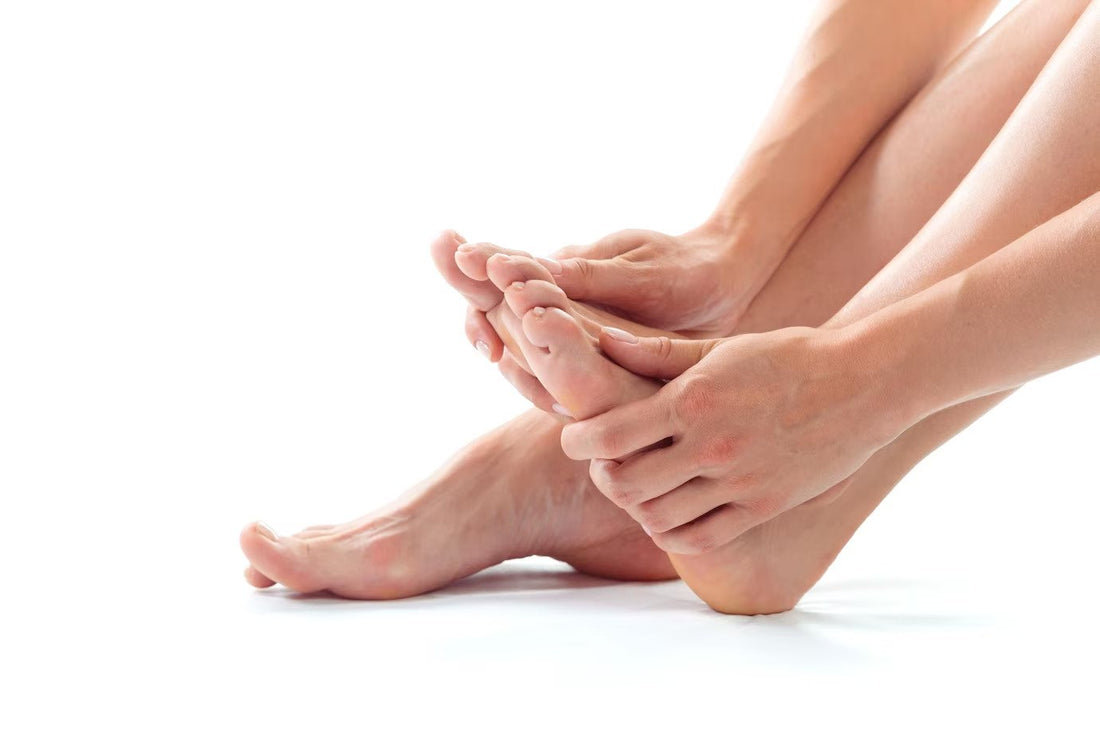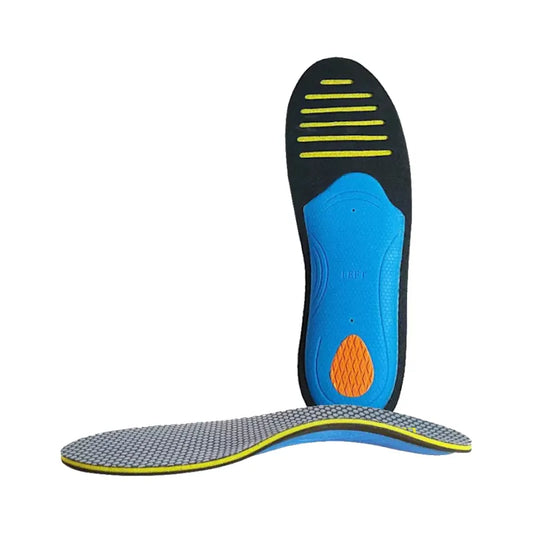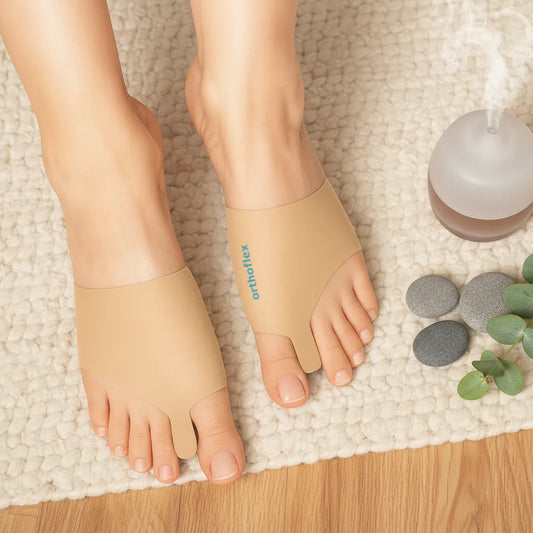
Are bunions hereditary?
Share
Bunions, known medically as hallux valgus, are bony bumps that form on the joint at the base of the big toe. Often causing discomfort, and sometimes severe pain, bunions are a common foot ailment that affects millions of people globally. Although it's frequently a subject of debate whether bunions are hereditary, scientific research indicates that genetics can play a significant role in their development. This article aims to dive into the anatomy, prevalence, and causes of bunions, their prevention, and treatment, as well as the role of genetics in their occurrence.

Understanding the Anatomy
The human foot is a complex structure consisting of numerous bones, tendons, and ligaments. The big toe has two important joints: the metatarsophalangeal (MTP) joint, connecting the first metatarsal bone of the foot and the first phalange of the toe, and the interphalangeal joint.
In a healthy foot, the big toe and its metatarsophalangeal (MTP) joint should point straight ahead. However, when a bunion form, an unusual force on the joint pushes it towards the smaller toes. As the MTP joint moves out of alignment, the body forms new bone to protect the joint, creating the characteristic bump of a bunion.
The resulting misalignment impacts the biomechanics of the foot, which can further contribute to the problem and can also cause issues in other parts of the foot and lower leg. Some people may develop additional problems such as hammertoes (a deformity in the middle joint of a toe), bursitis (inflammation of the small fluid-filled sacs that cushion the bones), or metatarsalgia (pain and inflammation in the ball of the foot).
Prevalence and Demographics
A 2011 study published in the journal "Arthritis Care & Research" reported that bunions are prevalent in about 36% of people over the age of 65. Younger individuals aren't spared either, with nearly 30% of people aged 18-65 having some form of bunion. This prevalence suggests that bunions aren't exclusively a concern for the elderly; they can develop at any age, particularly if there are underlying predisposing factors.
Gender-wise, studies show that women are significantly more likely to suffer from bunions than men. In a study published in the "Journal of Foot and Ankle Surgery," it was revealed that women are up to 10 times more likely to develop bunions than men. This gender disparity is partly attributed to footwear styles. Women tend to wear narrow, high-heeled shoes that place increased pressure on the forefoot and can exacerbate the development of bunions.
When focusing on the American population, a study known as the Framingham Foot Study found that 31% of adults in Framingham, Massachusetts, had bunions. The study participants were mostly of European descent, and it showed that older adults, women, and individuals with higher Body Mass Index were more likely to have bunions.
In terms of racial demographics, a 2010 study published in "Arthritis Care & Research" found that, in the United States, hallux valgus (bunions) and lesser toe deformities were highly prevalent among African Americans and whites but were significantly less common among Chinese Americans.
Another important demographic factor to consider is socioeconomic status. A study in the UK found that bunions were more common in people from lower socioeconomic groups. While these results may not translate directly to the American population, it's plausible that similar trends may exist, given the links between socioeconomic status and health outcomes.
Overall, bunions are a prevalent health issue affecting a diverse range of people across age, gender, and racial lines. However, certain populations such as older adults, women, and individuals with certain genetic and lifestyle factors are at a higher risk.
Causes and the Role of Hereditary
While the formation of a bunion involves a complex interplay of anatomical and environmental factors, research suggests a significant genetic component. Some people inherit a foot type (such as low arches or flat feet) that destabilizes the foot's natural mechanical function, making them more prone to developing bunions. Additionally, certain inherited connective tissue disorders may predispose individuals to bunions.
Despite this, environmental factors are critical. For instance, footwear plays a significant role in the development of bunions. Shoes that are too tight, wearing high heels or pointed toes can push the toes out of alignment. Occupations or activities that involve a lot of standing, walking, or repetitive stress on the feet without proper cushion can also contribute to bunion formation.
Prevention and Treatment
Preventing bunions involves addressing the factors that contribute to their development. Here are some strategies to prevent the formation of bunions:
- Proper Footwear - Choose shoes with a wide toe box, and avoid those that squeeze your toes or have excessively high heels. Orthotics can also help by correcting the foot's alignment and reducing stress on the MTP joint.
- Foot Exercises - Regular foot exercises can help maintain joint mobility, flexibility and strengthen the foot's muscles, thereby reducing the risk of bunions and keeping your feet functional.
- Healthcare appointment - Regular check-ups with a podiatrist or physiotherapist can help detect any early signs of bunions, allowing for timely intervention.
When it comes to treatment, non-surgical interventions are often the first step, and most of the time, when they are early detected, they have a good prognostic. The first line of treatment for bunions includes pain relievers, anti-inflammatory medications, and ice packs to help with pain management and also inflammation. Shoe modifications and custom foot orthotics to improve daily activities and make your day more pain-free or even to correct any bad alignment that’s a predisposition to this problem and physical therapy for a more personalized intervention and adequate strategies.
Surgical intervention, known as a bunionectomy, is usually considered when non-surgical treatments fail to provide relief, or when the bunion has advanced to a stage where it significantly interferes with daily activities and quality of life. The specific surgical techniques used vary based on the severity of the bunion and the individual's health.
Conclusion
In conclusion, while bunions are a common foot ailment with a significant hereditary component, they are not an inevitable consequence of our genetics. Modifiable factors like footwear and foot care play a crucial role in bunion prevention and management. Individuals who are at a higher risk due to their family history can take proactive steps to minimize their risk and seek early treatment if they notice the signs of a bunion developing. Don’t forget to keep your feet healthy and do frequent check-ups with your doctor in order to act as soon as possible when you have a genetic predisposition for bunions in your family and always remember that each case is different, so you should seek medical help for your own condition.
Author Bio

Marlene Carvalho
Certified Sports Physiotherapist of Elite and Olympic athletes; Performance Coach to racing drivers
Marlene Carvalho is a sports physiotherapist passionate about all things sports.
References
- Nix, S., Smith, M., & Vicenzino, B. (2010). Prevalence of hallux valgus in the general population: a systematic review and meta-analysis. Journal of Foot and Ankle Research, 3(1), 21.
- Menz, H. B., Roddy, E., Thomas, E., & Croft, P. R. (2011). Impact of Hallux valgus severity on general and foot-specific health-related quality of life. Arthritis Care & Research, 63(3), 396-404.
- Nguyen, U. S., Hillstrom, H. J., Li, W., Dufour, A. B., Kiel, D. P., Procter-Gray, E., Gagnon, M. M., & Hannan, M. T. (2010). Factors associated with hallux valgus in a population-based study of older women and men: the MOBILIZE Boston Study. Osteoarthritis and Cartilage, 18(1), 41-46.
- Perera, A. M., Mason, L., & Stephens, M. M. (2011). The pathogenesis of hallux valgus. The Journal of Bone and Joint Surgery. American Volume, 93(17), 1650-1661.
- Saro, C., Jensen, I., Lindgren, U., & Felländer-Tsai, L. (2007). Quality-of-life outcome after hallux valgus surgery. Quality of Life Research, 16(5), 731-738.
- Piqué-Vidal, C., Solé, M. T., & Antich, J. (2007). Hallux valgus inheritance: pedigree research in 350 patients with bunion deformity. Journal of Foot and Ankle Surgery, 46(3), 149-154.
- Menz, H. B., Morris, M. E., & Lord, S. R. (2005). Foot and ankle characteristics associated with impaired balance and functional ability in older people. Journal of Gerontology Series A: Biological Sciences and Medical Sciences, 60(12), 1546-1552.






